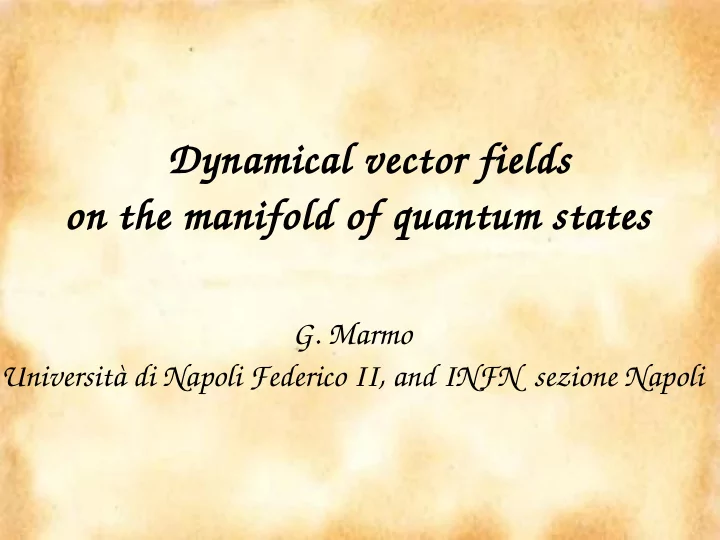

Dynamical vector fields on the manifold of quantum states G. Marmo Università di Napoli Federico II, and INFN sezione Napoli G. Marmo: Dynamical vector fields on the m anifold of quantum states
To describe any physical system we need to identify: ● States ● Observables ● Probability function ● Evolution equation ● Composition rule of systems G. Marmo: Dynamical vector fields on the m anifold of quantum states G. Marmo: Dynamical vector fields on the manifold of quantum states
Classical systems A symplectic manifold States: probability distibutions or probability measures, Liouville measure, comparison measure Observables: Probability function: for any Borelian , a state, observable: Probability to find a value of in when the system is in the state Evolution: Composition: G. Marmo: Dynamical vector fields on the m anifold of quantum states G. Marmo: Dynamical vector fields on the manifold of quantum states
Quantum systems (Schrӧdinger picture) “wave mechanics”: complex separable Hilbert space (Pure) States: rays in complex projective space, Hilbert manifold Observables: real elements in Probability function: for any res. of the identity and any vector similarly Evolution: Composition: G. Marmo: Dynamical vector fields on the m anifold of quantum states G. Marmo: Dynamical vector fields on the manifold of quantum states
Quantum systems (Heisenberg picture) “matrix mechanics”: a C*algebra Observables: real elements in States: normalized, positive, linear functionals on GNS construction gives back a Hilbert space Probability function: Evolution: Composition: G. Marmo: Dynamical vector fields on the m anifold of quantum states G. Marmo: Dynamical vector fields on the manifold of quantum states
Quantum systems Other pictures: ● WeylWigner ● Generalized coherent states ● Tomographic picture ● Linearity versus nonlinearity G. Marmo: Dynamical vector fields on the m anifold of quantum states G. Marmo: Dynamical vector fields on the manifold of quantum states
Probabilisticstatistical interpretation of quantum mechanics. The primary object is the space of states (we shall consider only finitedimensional systems). SchrӧdingerDirac picture: The Hilbert manifold of pure states. Heisenberg, BornJordan: A connected closed complete and convex set S in some affine topological space E. The space of states is a stratified manifold (the boundary is not a smooth manifold) with two compatible contravariant tensor fields: Skewsymmetric, defines a Poisson bracket Symmetric, defines a Jordan algebra G. Marmo: Dynamical vector fields on the m anifold of quantum states G. Marmo: Dynamical vector fields on the manifold of quantum states
Observables are realvalued functions on S with the following properties: Hamiltonian vector fields with the Killing property Gradient vector fields Hamiltonian and gradient vector fields generate the tangent bundle of S, for every stratum, and close on the Lie algebra of We find that: ● Observables constitute a LieJordan algebra; ● By extension to complexvalued combinations of observables we generate a C*algebra. By using a GNS construction we recover a Hilbert space. The irriducibility requirement (a minimality condition) allows to recover the Hilbert space of the SchrӧdingerDirac picture G. Marmo: Dynamical vector fields on the m anifold of quantum states G. Marmo: Dynamical vector fields on the manifold of quantum states
Example: Qbit States, Bloch ball in Observables They generate the Lie algebra of If we consider a realization of the Lie algebra in terms of matrices we get back the complex matrix algebra generated by G. Marmo: Dynamical vector fields on the m anifold of quantum states G. Marmo: Dynamical vector fields on the manifold of quantum states
Example: Qbit The LieJordan algebra: We can define so that: G. Marmo: Dynamical vector fields on the m anifold of quantum states G. Marmo: Dynamical vector fields on the manifold of quantum states
Example: Qbit Remark: since we are using tensor fields, we are free to perform every nonlinear change of coordinates. The convexity is hidden. For instance, in spherical coordinates we have: It is clear by inspection that Hamiltonian and gradient vector fields are tangent to the sphere of pure states, r=1. The interior of the ball is an orbit of is generated by by means of G. Marmo: Dynamical vector fields on the m anifold of quantum states G. Marmo: Dynamical vector fields on the manifold of quantum states
Let us consider the KossakowskiLindblad equation: say with We see immediately that the equations of motion split into: ● Hamiltonian term; ● Symmetric term; ● Kraus term. G. Marmo: Dynamical vector fields on the m anifold of quantum states G. Marmo: Dynamical vector fields on the manifold of quantum states
It is possible to write a vector field with this equation of motion. It turns out that the one associated with the Kraus term is a nonlinear vector field, similar to the nonlinear vector field associated with the symmetric tensor (the gradient vector field). Example: the phasedamping of a qbit The “miracle” of the KossakowskiLindblad equation is that the two nonlinearities camcel each other so that the resulting vector field is actually linear! G. Marmo: Dynamical vector fields on the m anifold of quantum states G. Marmo: Dynamical vector fields on the manifold of quantum states
Summarizing ● On the space of quantum states, Hamiltonian and gradient vector fields generate the action of a Lie group: ● To describe semigroups we have to introduce Kraus vector fields. ● Having described the dynamics in terms of vector fields will provide a framework to describe nonMarkovian dynamics. ● The tensorial description allows for generic nonlinear transformations, hopefully more flexible to deal with nonlinearities, like entanglement, entropies and so on. G. Marmo: Dynamical vector fields on the m anifold of quantum states G. Marmo: Dynamical vector fields on the manifold of quantum states
Recommend
More recommend